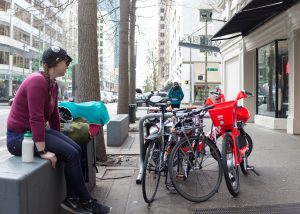A running joke in the cycling community is that we always have free parking. As long as there’s a sturdy pole in sight, cyclists can forego the hunt for parking spaces and evade the clutches of prowling meter maids. At a time when daily commutes are more daunting than ever, sparked by the growing pains of a blooming economic hub and the infamous #Viadoom viaduct closure, these space-saving, pedal-powered commuters are a saving grace to the city’s congested streets. But as Seattle seeks to expand its free-floating bike share programs –those red and green bicycles dotting the streets– new regulations have the potential to snub cyclists.
According to Seattle’s updated permit regulations, it appears that all free-floating bike share companies, currently Lime and JUMP, may “require or encourage” users to lock shared bicycles to city bike racks beginning March 15, 2019. This regulation, in conjunction with Seattle simultaneously doubling the amount of free-floating bicycles allowed in the city, will likely make bike racks inaccessible to bike owners. In response, many cyclists may resort to alternate commuting methods.
Granted, the Seattle Department of Transportation plans to accommodate free-floating bikes with an “almost 20%” increase in bike racks. However, from a cyclist perspective, a 20% increase to Seattle’s already sparse bike rack numbers is unlikely to relieve the congestion of up to 20,000 free-floating bikes. No, that’s not an exaggerated number. Bike racks will face up to 20,000 free-floating bikes come March. For reference, picture the amount of Uber’s JUMP bikes dispersed throughout the city around November. That number was 1,000. Uber plans to quintuple that number to around 5,000 bikes come March 2019. Combined with Lime and soon-to-be contender Lyft bikes, bike commuters take heed.
Seattle’s push to move free-floating bikes to the periphery of sidewalks is an important initiative, however. While an abandoned bicycle clogging a city sidewalk may be a slight hindrance to some, it could be a significant barrier to those with accessibility needs. With this in mind, Seattle’s new bike share regulations are a necessary move to increase accessibility throughout the city. However, it seems counter-intuitive for the city to dissuade bike commuting in the wake of already exacerbated transportation issues.







Be First to Comment